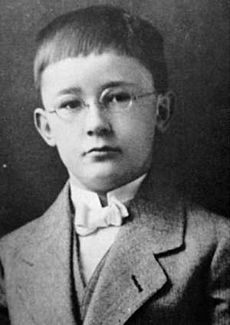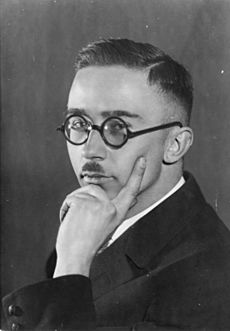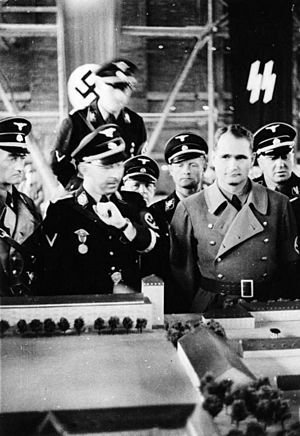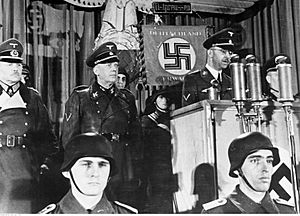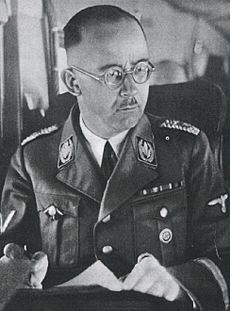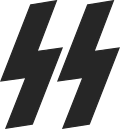Heinrich Himmler facts for kids
Quick facts for kids
Heinrich Himmler
Reichsleiter
|
|
|---|---|
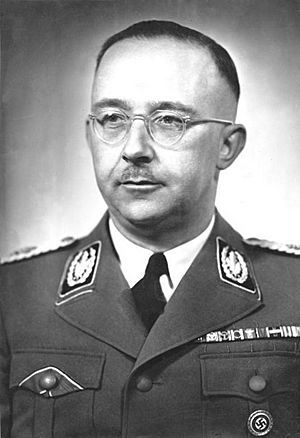
Official portrait, 1942
|
|
| 4th Reichsführer-SS | |
| In office 6 January 1929 – 29 April 1945 |
|
| Deputy | Reinhard Heydrich |
| Preceded by | Erhard Heiden |
| Succeeded by | Karl Hanke |
| Chief of German Police | |
| In office 17 June 1936 – 29 April 1945 |
|
| Preceded by | Office established |
| Succeeded by | Karl Hanke |
| Director of the Reich Security Main Office | |
| Acting 4 June 1942 – 30 January 1943 |
|
| Minister | Wilhelm Frick |
| Preceded by | Reinhard Heydrich |
| Succeeded by | Ernst Kaltenbrunner |
| Reichsminister of the Interior | |
| In office 24 August 1943 – 29 April 1945 |
|
| Chancellor | Adolf Hitler |
| Preceded by | Wilhelm Frick |
| Succeeded by | Paul Giesler |
| Commander of the Replacement Army | |
| In office 21 July 1944 – 29 April 1945 |
|
| Preceded by | Friedrich Fromm |
| Succeeded by | Office abolished |
| Personal details | |
| Born |
Heinrich Luitpold Himmler
7 October 1900 Munich, Kingdom of Bavaria, German Empire |
| Died | 23 May 1945 (aged 44) Lüneburg, Province of Hanover, Allied-occupied Germany |
| Cause of death | Suicide by cyanide poisoning |
| Political party | Nazi Party (1923–1945) |
| Spouse | |
| Children |
|
| Relatives |
|
| Education | Technische Universität München |
| Signature | |
| Military service | |
| Allegiance | |
| Branch/service | |
| Years of service | 1917–1918 (Army) 1925–1945 (SS) |
| Rank | Fahnenjunker Reichsführer-SS |
| Unit | 11th Bavarian Infantry Regiment |
| Commands | Army Group Upper Rhine Army Group Vistula Replacement (Home) Army |
| Battles/wars | World War II |
Heinrich Luitpold Himmler (born October 7, 1900 – died May 23, 1945) was a very powerful leader in Nazi Germany. He was the head of the Schutzstaffel (SS), which was a large and powerful group within the Nazi Party. Himmler played a major role in planning and carrying out the terrible events of the Holocaust.
Himmler did not fight in World War I. He studied farming at university. He joined the Nazi Party in 1923 and the SS in 1925. In 1929, Adolf Hitler made him the leader of the SS. Over 16 years, Himmler turned the SS from a small group into a huge organization with over a million members. He also created and controlled the Nazi concentration camps. Himmler was known for being very organized and for choosing skilled people to work for him. From 1943, he was also the Chief of German Police and the Minister of the Interior. This meant he was in charge of all police and security forces, including the Gestapo (Secret State Police). He also controlled the Waffen-SS, which was the military part of the SS.
Himmler was responsible for forming special units called Einsatzgruppen and building extermination camps. He oversaw the Nazi plans to kill millions of people. This included about six million Jews, hundreds of thousands of Romani, and many other victims. In total, it is believed that 11 to 14 million civilians were killed by the Nazi regime. Most of these were people from Poland and the Soviet Union.
Towards the end of World War II, Hitler made Himmler a military commander. Himmler later tried to make peace with the western Allies without Hitler knowing. When Hitler found out, he removed Himmler from all his positions and ordered his arrest in April 1945. Himmler tried to hide, but British forces caught him. While he was being held by the British, he took his own life on May 23, 1945.
Contents
Himmler's Early Life and Education
Heinrich Luitpold Himmler was born in Munich, Germany, on October 7, 1900. He came from a middle-class family that followed the Roman Catholic faith. His father, Joseph Gebhard Himmler, was a teacher. Heinrich had two brothers, Gebhard Ludwig and Ernst Hermann.
Himmler went to a grammar school in Landshut. He was good at his schoolwork but struggled with sports. He often had health problems, including stomach issues. Even so, he tried to become stronger by exercising daily. Other students remembered him as being serious and a bit awkward around others.
Himmler kept a diary from when he was 10 years old. It showed he was interested in news, dueling, and talking about religion. In 1915, he started training with a cadet group. His father helped him join the army as an officer candidate in December 1917. However, World War I ended in November 1918 before he could become an officer or fight in battles.
After the war, Himmler finished school. From 1919 to 1922, he studied agriculture at the Munich Technical University. He had a short time working on a farm before this.
Joining Political Groups
Even though rules against non-Christians had been removed in Germany, antisemitism (hatred of Jewish people) was still common. Himmler became antisemitic by the time he went to university. He was still a Catholic student and spent time with a fencing club that had Jewish members. He remained polite to them despite his growing antisemitism.
Himmler wanted to join the military after university but could not. Instead, he became more involved in paramilitary groups in Munich. This is when he met Ernst Röhm, an early member of the Nazi Party. Himmler admired Röhm and joined his antisemitic group, the Imperial War Flag Society.
In 1922, Himmler became very interested in the "Jewish question." He read many antisemitic writings and books about German myths and the occult. After a German foreign minister was murdered in June, Himmler's political views became even more extreme. He took part in protests against the Treaty of Versailles, which was a peace treaty after World War I.
Germany was facing very high inflation at this time, and Himmler's parents could not afford to pay for all three sons' education. Himmler was disappointed he couldn't have a military career or study further. He had to take a low-paying office job after getting his farming diploma. He stayed in this job until September 1923.
Himmler's Role in the Nazi Party
Himmler joined the Nazi Party in August 1923. He was part of Röhm's group and was involved in the Beer Hall Putsch. This was an attempt by Hitler and the Nazi Party to take control in Munich, but it failed. Himmler was questioned by the police but not charged. However, he lost his job and had to move back in with his parents. These failures made him more angry and opinionated.
Between 1923 and 1924, Himmler stopped being Catholic and focused on the occult and antisemitism. He saw German mythology, mixed with occult ideas, as his new religion. He liked the Nazi Party because its ideas matched his own. At first, he wasn't impressed by Hitler's personality. But as he learned more, he began to admire Hitler. Himmler used the confusion in the Nazi Party after Hitler's arrest to improve his own position. From mid-1924, he worked for Gregor Strasser as a party secretary. He traveled around Bavaria, giving speeches and handing out Nazi materials.
In 1925, Himmler joined the Schutzstaffel (SS). The SS was first created in 1923 to protect Hitler personally. It was reformed in 1925 as an elite unit of the SA. Himmler's first leadership role in the SS was as a district leader in Lower Bavaria in 1926. In 1927, Strasser made Himmler his deputy propaganda chief. Himmler had a lot of freedom in this role. He started collecting information on Jews, Freemasons, and other "enemies" of the party. He also began to create a detailed system for managing things. In September 1927, Himmler told Hitler he wanted to make the SS a very loyal, powerful, and racially "pure" elite group. Hitler agreed and made him Deputy Reichsführer-SS.
Around this time, Himmler joined a youth group called the Artaman League. There he met Rudolf Höss, who later became the commandant of Auschwitz concentration camp. He also met Walther Darré, whose ideas about the "Nordic race" greatly influenced Himmler.
Himmler's Rise in the SS
In January 1929, Himmler became the leader of the SS, called Reichsführer-SS, with Hitler's approval. He also continued his work at the propaganda office. One of his first jobs was to organize SS members for the Nuremberg Rally in September. Over the next year, Himmler increased the SS from about 290 men to about 3,000. By 1930, he convinced Hitler to let the SS operate as a separate organization, even though it was still officially under the SA.
The Nazi Party gained power during the Great Depression by promising to fix the economy. Hitler became Chancellor of Germany on January 30, 1933. Less than a month later, the Reichstag fire happened. Hitler used this event to get a law passed that suspended basic rights and allowed people to be arrested without trial. Another law, the Enabling Act, gave Hitler's government full law-making powers. Germany became a dictatorship. When President Paul von Hindenburg died in 1934, Hitler combined the roles of president and chancellor, becoming both head of state and head of government.
Building the SS and Concentration Camps
With the Nazis in power, Himmler and the SS grew quickly. By 1933, the SS had 52,000 members. Himmler made sure that only people who fit Hitler's idea of the "Aryan master race" could join. He believed in carefully selecting members, like a gardener choosing the best plants.
Himmler was very organized and used his skills to set up different SS departments. In 1931, he appointed Reinhard Heydrich to lead the new intelligence service, which became the Sicherheitsdienst (SD: Security Service) in 1932. Himmler and Heydrich worked well together. In 1933, they started to make the SS independent from the SA. They also wanted to create a single German police force. Himmler became chief of the Munich Police in March 1933. He and Heydrich then took control of the political police in many other states.
Himmler also created the SS Race and Settlement Main Office (RuSHA). This department carried out racial policies and checked the "racial purity" of SS members. For example, in 1931, Himmler introduced a "marriage order." SS men who wanted to marry had to show family trees proving that both families were of "Aryan" descent back to 1800. If any non-Aryan ancestors were found, the person was removed from the SS. Himmler hoped that SS marriages would produce many children to create more "genetically superior" SS members. However, this plan did not work as well as he hoped.
In March 1933, Himmler set up the first official concentration camp at Dachau. Hitler said he didn't want it to be just another prison. Himmler appointed Theodor Eicke to run the camp in June 1933. Eicke created a system that was used as a model for other camps. This system included isolating prisoners, strict rules, and using force to make people obey. Prisoners and guards wore uniforms. By the end of 1934, Himmler took control of all camps under the SS.
At first, the camps held political opponents. Over time, other people considered "undesirable" by the Nazis were sent there, such as criminals and homeless people. In 1936, Himmler wrote that the SS would fight against "subhumans." A decree in 1937 allowed anyone considered "undesirable" to be imprisoned. This included Jews, Romani, communists, and anyone else the Nazis called Untermensch (sub-human). The camps became a way for the Nazis to control society and enforce their racial ideas. By the start of World War II in 1939, there were six camps holding about 27,000 prisoners, and many people died there.
Increasing Power and Control
In early 1934, Hitler and other Nazi leaders worried that Röhm, the head of the SA, was planning to take power. Röhm believed the SA, which had about three million men, should become the main armed force of the state.
Hermann Göring had created a secret police force called the Gestapo in 1933. On April 20, 1934, Göring gave control of the Gestapo to Himmler. On the same day, Hitler made Himmler chief of all German police outside Prussia. This was a big change because law enforcement had always been a local matter in Germany. Heydrich became chief of the Gestapo under Himmler.
Hitler decided that Röhm and other SA leaders needed to be removed. Between June 30 and July 2, 1934, many SA leaders and other political opponents were killed in what became known as the Night of the Long Knives. After this, the SA lost its power, and the SS became an independent organization, answering only to Hitler. Himmler's title, Reichsführer-SS, became the highest SS rank.
On September 15, 1935, Hitler introduced the Nuremberg Laws. These laws banned marriage between non-Jewish and Jewish Germans and took away German citizenship from "non-Aryans." These were some of the first race-based laws in Nazi Germany.
Himmler and Heydrich wanted to expand the SS's power. They pushed Hitler to create a national police force controlled by the SS. On June 17, 1936, Hitler ordered all police forces in Germany to be unified and named Himmler Chief of German Police. This made the police effectively a part of the SS, giving Himmler control over all of Germany's police forces. He also gained authority over all uniformed police agencies, which were combined into the Ordnungspolizei (Orpo: "order police") under the SS.
Himmler later created the Kriminalpolizei (Kripo: criminal police) for all criminal investigations. The Kripo and Gestapo were merged into the Sicherheitspolizei (SiPo: security police) under Heydrich. In September 1939, at the start of World War II, Himmler formed the SS-Reichssicherheitshauptamt (RSHA: Reich Security Main Office) to bring the SiPo and SD together. Heydrich was again put in charge.
Under Himmler, the SS also developed its own military branch, the SS-Verfügungstruppe, which became the Waffen-SS. This military force grew to over 38 divisions during World War II. They fought alongside the regular German army but were not formally part of it.
Himmler also started to build a separate economy for the SS. In 1940, Oswald Pohl set up the German Economic Enterprise, which owned housing companies, factories, and publishing houses.
In 1938, Hitler ended Germany's alliance with China and made an agreement with Japan. That same year, Austria became part of Nazi Germany, and the Munich Agreement gave Germany control over parts of Czechoslovakia. Hitler's main reasons for war included gaining more Lebensraum ("living space") for Germans, who were seen as racially superior. Another goal was to remove those considered racially inferior, especially Jews and Slavs, from German-controlled areas. Many Jews left Germany between 1933 and 1938.
World War II and the Holocaust
When Hitler wanted a reason to invade Poland in 1939, Himmler, Heydrich, and Heinrich Müller planned a fake attack called Operation Himmler. German soldiers dressed in Polish uniforms carried out border fights to make it look like Poland was attacking Germany. This was used as an excuse for the invasion of Poland, which started World War II. At the beginning of the war, Hitler allowed the killing of Polish civilians, including Jews and ethnic Poles. Special SS units called Einsatzgruppen followed the army into Poland and murdered about 65,000 intellectuals and other civilians by the end of 1939. These units also gathered Jews and others to be sent to ghettos and concentration camps.
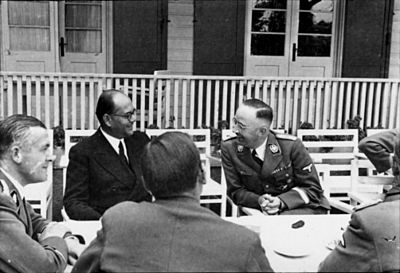
Germany then invaded other countries like Denmark, Norway, the Netherlands, and France. They also started bombing Great Britain. On June 21, 1941, the day before invading the Soviet Union, Himmler ordered the creation of the Generalplan Ost (General Plan for the East). This plan was finalized in July 1942. It called for taking over the Baltic States, Poland, Western Ukraine, and Belarus. Ten million German citizens would then move there. The people already living there—about 31 million—would be forced to move further east, starved, or used for forced labor. Himmler openly stated that 20 to 30 million Slavs and Jews would die.
Himmler said the war in the east was a fight to protect Europe from "Godless Bolshevik hordes." He created Waffen-SS units made up of people from the Balkans and eastern Europe, and also from northern and western Europe, like the Netherlands, Norway, and Belgium.
In late 1941, Hitler made Heydrich the Deputy Reich Protector of Protectorate of Bohemia and Moravia. Heydrich began to classify Czech people by race and sent many to concentration camps. He was known for his harsh actions. This strengthened Himmler's control over a state.
Before the invasion of the Soviet Union, Himmler brought back the Einsatzgruppen. These units followed the army into the Soviet Union and rounded up and killed Jews and others considered "undesirable." Hitler received regular reports on these killings. Also, 2.8 million Soviet prisoners of war died from starvation, bad treatment, or executions in just eight months during 1941–42. Many more died or were executed in concentration camps. By early 1941, Himmler had ordered ten concentration camps to be built for forced labor. Jews from all over Germany and occupied areas were sent to these camps or confined to ghettos. When the Germans failed to quickly defeat the Soviet Union, Hitler and other Nazi officials decided that mass deportations to the east were no longer possible. Instead, many Jews in Europe were marked for death.
The "Final Solution" and Racial Policy
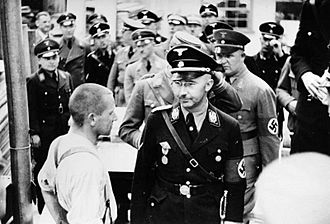
Nazi racial policies, which included the idea that people considered "racially inferior" had no right to live, were part of the Nazi Party from its beginning. Around December 1941, Hitler decided that the Jews of Europe should be "exterminated." Heydrich organized a meeting on January 20, 1942, at Wannsee near Berlin. Top Nazi officials attended this meeting to plan the "final solution to the Jewish question." Heydrich explained that Jews who could work would be worked to death, and those who couldn't would be killed immediately. He estimated that 11 million Jews would be killed and said Hitler had put Himmler in charge of the plan.
In June 1942, Heydrich was killed in Prague. Himmler took over leadership of the RSHA and sped up the killing of Jews in Aktion Reinhard (Operation Reinhard), named in Heydrich's honor. He ordered three extermination camps to be built at Bełżec, Sobibór, and Treblinka.
The Nazis also targeted Romani (Gypsies), calling them "asocial" and "criminals." By 1935, they were put in special camps. In 1938, Himmler ordered that the "Gypsy question" would be decided by "race." He believed Romani people were originally "Aryan" but had become a "mixed race." Only the "racially pure" were allowed to live. In 1939, Himmler ordered thousands of Gypsies to be sent to Dachau, and by 1942, all Romani were ordered to Auschwitz concentration camp.
Himmler was a key figure in the Holocaust. His strong belief in racist Nazi ideas led him to justify the murder of millions of victims. The Nazis planned to kill Polish intellectuals and limit non-Germans in conquered areas to a very basic education. They also wanted to create a "master race" of racially "pure" Nordic Aryans in Germany. Himmler, who had studied agriculture, wanted to apply ideas of selective breeding to humans.
Speeches in Posen
On October 4, 1943, Himmler gave a secret speech to top SS officials in Poznań (Posen). On October 6, 1943, he spoke to the Nazi Party elite. In these speeches, Himmler openly talked about the "extermination" (German: Ausrottung) of the Jewish people.
Hitler wanted all party leaders to be involved in the ongoing killings so they couldn't deny knowing about them later. This is why Hitler allowed Himmler to give these speeches.
Germanization Plans
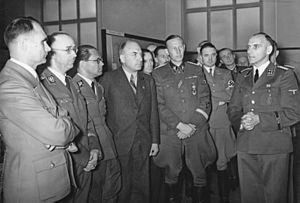
As the Reich Commissioner for the Consolidation of German Nationhood, Himmler was deeply involved in the Germanization program for Eastern Europe, especially Poland. The goal of the General Plan for the East was to enslave, expel, or kill the local population to create Lebensraum ("living space") for Volksdeutsche (ethnic Germans). Himmler continued these plans even when many Germans did not want to move there, and despite the negative impact on the war effort.
Himmler's racial classifications started with the Volksliste, which categorized people believed to have German blood. This included Germans who had worked with Germany before the war, those who saw themselves as German but were neutral, those who were partly "Polonized" but could be "Germanized," and Germans who were Polish citizens. Himmler ordered that anyone who refused to be classified as ethnic German should be sent to concentration camps, have their children taken away, or be forced to work.
The plan also included the kidnapping of children from Eastern Europe. Children considered "racially valuable" were taken away from their Polish families and raised as Germans with German names. Himmler believed that German blood would always show itself, even if it had mixed with other nationalities. These children were to be adopted by German families. Children who were first accepted but later rejected were sent to children's concentration camps, where most of them died.
By January 1943, Himmler reported that 629,000 ethnic Germans had been moved. However, most did not live on small farms as planned but in temporary camps or towns. Half a million people from annexed Polish areas, Slovenia, Alsace, Lorraine, and Luxembourg were sent to the General Government or to Germany as forced laborers. Himmler warned that Germans should see all foreign workers brought to Germany as a danger to their "German blood."
The 20 July Plot and Increased Power
On July 20, 1944, a group of German army officers, including Claus von Stauffenberg, tried to kill Hitler. They failed. The next day, Himmler formed a special group that arrested over 5,000 people suspected of being against the regime. Hitler ordered harsh punishments, leading to the execution of more than 4,900 people. Although Himmler was embarrassed that he didn't discover the plot earlier, it actually gave him more power.
General Friedrich Fromm, who was the commander of the Replacement Army (Ersatzheer) and Stauffenberg's boss, was involved in the plot. Hitler removed Fromm and made Himmler his successor. The Replacement Army had two million men, and Himmler hoped to use them to fill positions in the Waffen-SS. He appointed Hans Jüttner as his deputy and started putting SS men in top Replacement Army jobs. By November 1944, Himmler had combined the army's officer recruitment with that of the Waffen-SS.
By this time, Hitler had also made Himmler the Reichsminister of the Interior, replacing Frick. Himmler also joined the Council of Ministers for the Defense of the Reich, which acted as the war cabinet. In August 1944, Hitler allowed Himmler to reorganize the Waffen-SS, the army, and the police. As head of the Replacement Army, Himmler was now responsible for prisoners of war. He also controlled the army's punishment system and the development of army weapons until January 1945.
Himmler's Military Commands
On June 6, 1944, the Western Allied armies landed in northern France during Operation Overlord. To fight them, the Army Group Upper Rhine was formed. In late 1944, Hitler made Himmler its commander-in-chief.
On September 26, 1944, Hitler ordered Himmler to create special army units called the Volkssturm ("People's Army"). All men aged sixteen to sixty were to join this militia. Armaments Minister Albert Speer protested, saying that skilled workers were being taken away from making weapons. Hitler believed six million men could be raised, but this was overly optimistic. By October 1944, children as young as fourteen were joining. Because of severe shortages and lack of training, the Volkssturm members were not ready for combat. About 175,000 of them died in the final months of the war.
On January 1, 1945, Hitler launched Operation North Wind. This was the last major German attack of the war. After some initial gains, the Americans stopped the attack, and it ended on January 25.
On January 25, 1945, despite Himmler's lack of military experience, Hitler appointed him commander of the quickly formed Army Group Vistula. This group was supposed to stop the Soviet Red Army's advance into Pomerania. Himmler set up his command center on his special train, which had poor communication equipment. Himmler rarely left the train and worked only about four hours a day.
Himmler was unable to create any good plans for his military goals. Under pressure from Hitler about the worsening war situation, Himmler became anxious and couldn't give clear reports. When his counter-attack failed, Hitler blamed Himmler and accused him of not following orders. Himmler's military command ended on March 20, when Hitler replaced him. By this time, Himmler had gone to a sanatorium for medical care. Himmler's failure and Hitler's reaction showed how much their relationship had broken down.
Peace Talks
In early 1945, Germany was losing the war, and Himmler's relationship with Hitler was very bad. Himmler thought about trying to negotiate peace on his own. His masseur, Felix Kersten, who had moved to Sweden, helped him talk with Count Folke Bernadotte, the head of the Swedish Red Cross.
Himmler and Hitler met for the last time on April 20, 1945, Hitler's birthday. Himmler promised to be loyal to Hitler. After the meeting, Himmler quickly left Berlin. On April 21, Himmler met with Norbert Masur, a Swedish representative, to discuss releasing Jewish concentration camp prisoners. Because of these talks, about 20,000 people were released in the White Buses operation. Himmler falsely claimed that the crematoria at the camps were built for people who died from typhus, not for murder. He also lied about high survival rates at camps like Auschwitz.
On April 23, Himmler met directly with Bernadotte in Lübeck. Himmler claimed to be the temporary leader of Germany and said Hitler would die soon. He hoped that the British and Americans would fight the Soviets alongside the remaining German army. Himmler asked Bernadotte to tell General Dwight Eisenhower that Germany wanted to surrender to the Western Allies, not to the Soviet Union. Bernadotte asked Himmler to write down his proposal, which Himmler did.
Meanwhile, Hermann Göring had sent a telegram asking Hitler for permission to take over leadership. Hitler saw this as a betrayal. On April 28, the BBC reported on Himmler's secret talks with the Allies. Hitler, who had always considered Himmler very loyal, was furious. He ordered Himmler's arrest.
The Soviets were very close to Hitler's bunker. This news, combined with Himmler's betrayal, made Hitler write his last will and testament. In this document, completed on April 29, the day before he took his own life, Hitler declared both Himmler and Göring traitors. He removed Himmler from all his positions and expelled him from the Nazi Party.
Hitler named Karl Dönitz as his successor. Himmler met Dönitz and offered to be his second-in-command. He believed the SS would be important for restoring order after the war. However, Dönitz refused Himmler's offers and started peace talks with the Allies. On May 6, two days before Germany surrendered, Dönitz formally dismissed Himmler from all his posts.
Capture and Death
After being rejected by his former comrades and hunted by the Allies, Himmler tried to hide. He used fake papers under the name Sergeant Heinrich Hizinger. With a few companions, he traveled south. On May 21, Himmler and two aides were stopped and detained by former Soviet prisoners of war at a checkpoint. Over the next two days, he was moved to several camps. On May 23, he was brought to a British interrogation camp near Lüneburg. Officials noticed that Himmler's identity papers had a stamp used by fleeing SS members.
The officer in charge, Captain Thomas Selvester, began a routine questioning. Himmler admitted who he was. Himmler was then taken to the headquarters of the Second British Army in Lüneburg for a medical exam. The doctor tried to examine Himmler's mouth, but Himmler pulled his head away. Himmler then bit into a hidden potassium cyanide pill and collapsed. He died within 15 minutes. Himmler's body was later buried in an unmarked grave near Lüneburg. The exact location of his grave is still unknown.
Himmler's Family Life
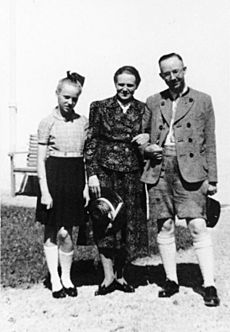
Himmler met his future wife, Margarete Boden, in 1927. She was seven years older than him and was a nurse. They both liked herbal medicine. They married in July 1928. Their only child, Gudrun, was born on August 8, 1929. They also fostered a boy named Gerhard von Ahe. Margarete sold her share of a clinic to buy land near Munich, where they built a house. Himmler was often away for party work, so Margarete managed their efforts to raise livestock, which were not very successful.
After the Nazis came to power, the family moved to Munich and then to Lake Tegern in 1934, where they bought a house. Himmler also got a large house in Berlin for free as an official residence. Himmler was so busy with work that he and his wife saw little of each other, and their relationship became difficult. They did attend social events together and Margarete often hosted wives of senior SS leaders for tea.
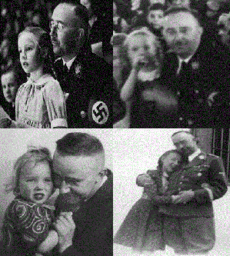
Margarete and Gudrun left their home as Allied troops advanced. They were arrested by American troops in Italy and held in various camps. They were later brought to Nuremberg to testify at the trials and were released in November 1946. Gudrun was very upset by her experience and remained loyal to her father's memory. She later worked for the West German spy agency from 1961 to 1963.
Images for kids
See also
 In Spanish: Heinrich Himmler para niños
In Spanish: Heinrich Himmler para niños
- Glossary of Nazi Germany
- Heinrich Himmler papers
- Lebensborn
- List of Nazi Party leaders and officials
- List of SS personnel


